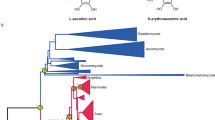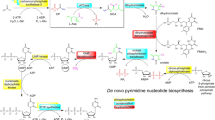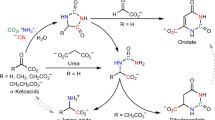Abstract
IT has been reported1 that cyanide greatly stimulates the synthesis of L-ascorbic acid from D-glucuronolactone by the liver microsomes of the rat. By this method using cyanide it was found that either the liver or the kidney tissue of all the species examined which are known to be independent of an exogenous source of ascorbic acid was able to synthesize L-ascorbic acid, while the corresponding tissue of those which are dependent on such a source could not. Whether the enzyme system concerned was present in the liver or the kidney tissue depended on the position of the species in the phylogenetic scale of evolution2. This technique revealed further that, apart from man, monkey and the guinea pig, the India fruit bat (Pteropus medius) and the redvented bulbul (Pycnonotus cafer) were unable to synthesize L-ascorbic acid, and this was confirmed by the production of experimental scurvy in the bulbul and its cure by the administration of L-ascorbic acid3. This communication concerns the location of the genetic defect in all these species, which distinguishes them from those which can synthesize L-ascorbic acid.
This is a preview of subscription content, access via your institution
Access options
Subscribe to this journal
Receive 51 print issues and online access
$199.00 per year
only $3.90 per issue
Buy this article
- Purchase on Springer Link
- Instant access to full article PDF
Prices may be subject to local taxes which are calculated during checkout
Similar content being viewed by others
References
Chatterjee, I. B., Ghosh, N. C., Ghosh, J. J., and Guha, B. C., Sci. and Cult., 23, 382 (1958).
Roy, R. N., and Guha, B. C., Nature, 182, 319 (1958).
Roy, R. N., and Guha, B. C., Nature, 182, 1689 (1958).
Chatterjee, I. B., Chatterjee, G. C., Ghosh, N. C., Ghosh, J. J., and Guha, B. C., Biochem. J., 74, 193 (1960).
Burns, J. J., Peyser, P., and Moltz, A., Science, 124, 1148 (1956).
Burns, J. J., Nature, 180, 553 (1957).
Suzuki, K., Mano, Y., and Shimazono, N., J. Biochem. (Japan), 47, 848 (1960).
Chatterjee, I. B., Kar, N. C., Ghosh, N. C., and Guha, B. C., Ann. N.Y. Acad. Sci., 92, 36 (1961).
Author information
Authors and Affiliations
Rights and permissions
About this article
Cite this article
CHATTERJEE, I., KAR, N., GHOSH, N. et al. Biosynthesis of L-Ascorbic Acid: Missing Steps in Animals incapable of synthesizing the Vitamin. Nature 192, 163–164 (1961). https://doi.org/10.1038/192163a0
Issue Date:
DOI: https://doi.org/10.1038/192163a0
This article is cited by
-
Biomarkers of oxidative stress, antioxidant defence and inflammation are altered in the senescence-accelerated mouse prone 8
AGE (2013)
-
Metabolic profiling of vitamin C deficiency in Gulo−/− mice using proton NMR spectroscopy
Journal of Biomolecular NMR (2011)
-
The history of vitamin C research in India
Journal of Biosciences (2009)
-
Cellular and molecular mechanisms of cigarette smoke-induced lung damage and prevention by vitamin C
Journal of Inflammation (2008)
-
Black tea prevents cigarette smoke-induced apoptosis and lung damage
Journal of Inflammation (2007)
Comments
By submitting a comment you agree to abide by our Terms and Community Guidelines. If you find something abusive or that does not comply with our terms or guidelines please flag it as inappropriate.



